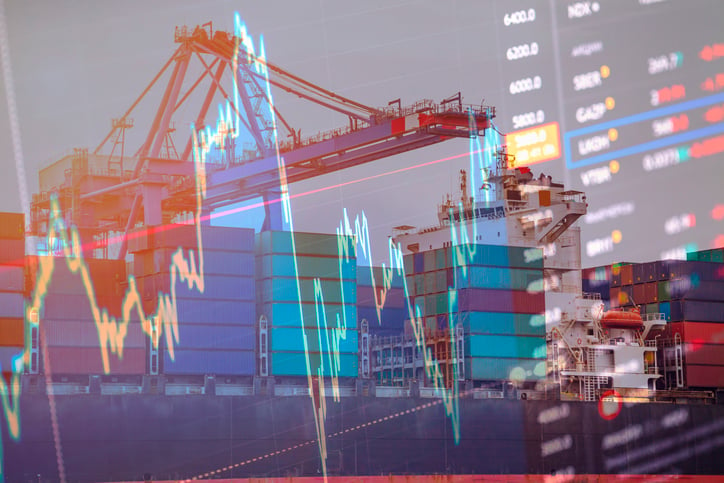Making Sense of the Supply Chain

The past few years have been characterized by one supply chain disruption after another, including coronavirus pandemic-related lockdowns, commodity shortages, port congestion, inflation, labor issues and logistics challenges.
“It used to be a called black swan event, but I think if we were to have a white swan event, which is no disruptions, we’d be lucky,” said Glenn Wilensky, vice president of customer service at Resilinc, a Milpitas, California-based provider of supply chain risk-management research and analytics. “Everything is a black swan event.”
“What’s interesting, in terms of events,” said Tom Linton, a senior adviser at global management consulting firm McKinsey & Company, “is the (coronavirus) pandemic is just like (on) a slow boil now. It’s in constantly in the background; it’s not even dealt with specifically. … It raises the overall risk of everything that’s done.”
Linton, who headlined “The State of the Supply Chain,” a recent webinar hosted by Resilinc, calls such pandemic-driven risk “consequential risk,” similar to consequential damages in law. Such risk often isn’t thought about, but once it occurs, it tends to expand and create additional disruption, as has been seen in the shortages of semiconductors and other products and materials, he says.
“We’ve introduced new risks into our supply chains,” like cyberattacks and software crashes that result in system downtime, said Linton, winner of the 2019 J. Shipman Gold Medal Award presented by Institute for Supply Management® (ISM®) for career excellence. Supply management organizations must develop backup plans to deal with such risk and disruption, he said.
Wilensky commented that it’s imperative that organizations map their supply chains to develop visibility into the lower tiers. According to Resilinc data, most organizations have visibility into their Tier-1 suppliers, but only 20 percent have visibility into Tier 2 and 5 percent into Tier 3, which creates greater risk, he said.
“When the first tier says, ‘Trust me, we have this figured out,’ I go back to, ‘Trust, but verify,’ ” Linton said. “You’re on the hook. Just because the supplier says it has you covered doesn’t mean you’re not responsible for it.”
Disruptions will continue to occur, he said. “It’s just how soon will you know about it,” he said. “I always say supply chains are selfish. If you find out something before someone else, you can take corrective action,” such as increasing inventory. Having visibility into lower tiers can increase insight into potential disruption and enable an organization to act more quickly than its competitors while reducing risk, Linton said.
Another consideration is that boards of directors and customers are demanding visibility, he added.
Time and Distance
There’s been a lot of talk about how nearshoring and reshoring can reduce sourcing issues made more apparent by COVID-19. Linton mentioned that he prefers the term “safeshoring,” saying, “No matter where you are, there’s less risk in what’s nearby.”
Supply chains don’t have to stay the same; they can be changed to become more proactive and less risk-prone, he said.
“Supply chains are about time (and) distance,” Linton said. “The balance sheet of a supply chain basically is cash, material and motion. How do you do that better? You compress it. You compress time. You shorten the distances. You have less risk when things are nearby. You do things safer and better.”
Rising interest rates likely will impact global sourcing — and use of ocean freight, Linton said. “One day of inventory (on a ship) in the ocean is one day of cash that’s confined in that material while it’s moving across the ocean,” he said, adding that airfreight may get a boost.
Further Disruption
Linton and Wilensky also discussed other supply chain topics, including:
- The impact of geopolitics on supply chains and how corporate social responsibility (CSR) is becoming a bigger imperative, as boards of directors as well as consumers are demanding supply chain visibility.
- Potential conflict in Taiwan, particularly pertaining to the global semiconductor market. The country is set to increase its global chipmaking market share. “I’d be a lot more worried about an earthquake … in Taiwan than China invading Taiwan,” Linton said. “Taiwan is an earthquake-prone country,” and an earthquake could hugely impact chip production there.
- “I would say the No. 1 issue that organizations are going to face in the next 12 months is inventory,” Linton said. “Any recession tends to slow down economic growth to the point where inventory backs up in the supply chain.” With major retailers sitting on a lot of inventory, they will need to discount it to sell it, which will drive down inflation, he said.
Linton added, “We’re probably going to have less of an inflationary period and more of a recessionary slowdown driven by (rising) interest rates.” This will make inventory more expensive because it’s cash that’s tied up. Visibility will play a part in this, he added.
Over the past few years, supply management professionals have elevated their influence and value, and become more powerful, Linton said: “We need to speak up about de-risking the world and de-risking supply chains and trying to get to the point where our voice is heard more loudly.” Supply chain professionals have a “voice to articulate a safer way forward,” he added.


